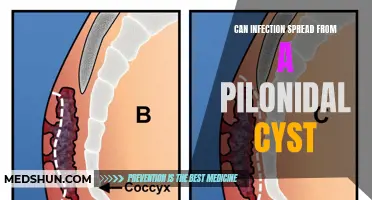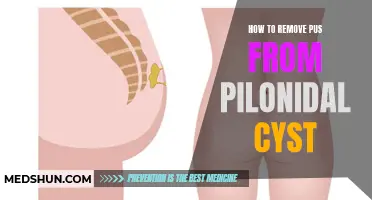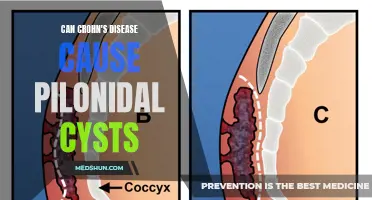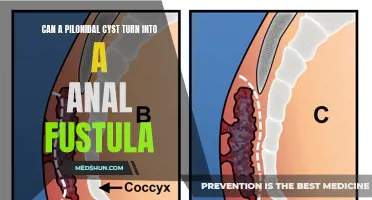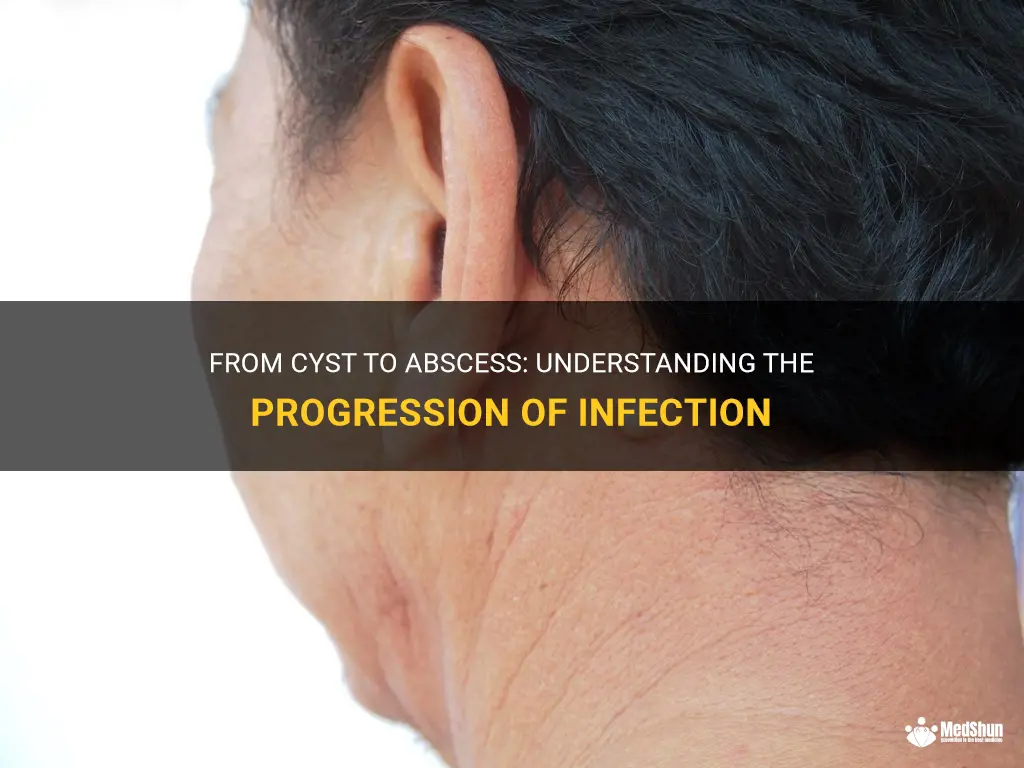
Cysts and abscesses – two common medical terms that may seem similar but actually have distinct differences. While cysts are typically harmless and can often go unnoticed, abscesses can be painful and require prompt medical attention. However, can a cyst turn into an abscess? This intriguing question delves into the potential transformation of a seemingly harmless mass into a painful and potentially severe infection. Join us as we explore the fascinating world of medical anomalies and unravel the connection between cysts and abscesses.
| Characteristics | Values |
|---|---|
| Development | A cyst can develop into an abscess. |
| Infection | An untreated cyst can become infected and turn into an abscess. |
| Severity | The severity of the infection can determine if a cyst becomes an abscess. |
| Pus Formation | An abscess is characterized by the formation of pus. |
| Pain and Swelling | A cyst turning into an abscess can cause pain and swelling at the site. |
| Treatment | Abscesses usually require medical treatment, such as drainage or antibiotics. |
| Complications | If left untreated, an abscess can lead to more serious complications. |
| Risk Factors | Certain factors, such as a weakened immune system, can increase the risk of a cyst turning into an abscess. |
| Location | An abscess can occur in various locations, including the skin, organs, or even tooth. |
| Diagnosis | A healthcare professional can diagnose an abscess through physical examination and medical imaging, such as ultrasound or CT scan. |
What You'll Learn
- What is the difference between a cyst and an abscess?
- What are the common causes of a cyst turning into an abscess?
- Are there any symptoms or warning signs that a cyst may be turning into an abscess?
- How is a cyst treated before it potentially becomes an abscess?
- Can an abscess caused by a cyst be prevented?

What is the difference between a cyst and an abscess?
Cysts and abscesses are both types of fluid-filled pockets that can develop in different parts of the body. While they may appear similar, there are distinct differences between the two.
Cysts are typically non-cancerous growths that form within tissues. They are sac-like structures filled with fluid, semi-solid material, or gas. Cysts can occur in various organs or tissues, including the skin, ovaries, breasts, and kidneys. They can range in size from very small to several centimeters in diameter.
There are different types of cysts based on their location and cause. Some common types include epidermal cysts, which form beneath the skin, ovarian cysts, which develop in the ovaries, and renal cysts, which occur in the kidneys. Cysts can also form due to genetic conditions, infections, or as a result of an injury or blocked duct.
On the other hand, abscesses are localized areas of infection that are surrounded by inflamed tissue. They are typically filled with pus, a thick fluid consisting of dead cells, tissue debris, and bacteria. Abscesses are usually caused by bacterial infections, such as staphylococcus or streptococcus, and can develop in various parts of the body, including the skin, organs, and even the brain.
Unlike cysts, abscesses are often painful and can cause symptoms such as redness, swelling, warmth, and tenderness in the affected area. They may also be accompanied by a fever and general feeling of being unwell. Abscesses can develop when bacteria enters the body through a wound, hair follicle, or other opening, and the immune system is not able to eliminate the infection.
Diagnosing the difference between a cyst and an abscess usually requires a physical examination, imaging tests, and sometimes a sample of the fluid inside the pocket. Imaging techniques such as ultrasound, CT scans, or MRIs can help visualize the characteristics of the growth and determine whether it is a cyst or an abscess. In some cases, a healthcare provider may also opt to perform a needle aspiration or biopsy to collect a sample for further analysis.
Treatment for cysts and abscesses varies depending on their location, size, and cause. Small, non-bothersome cysts often do not require treatment and can resolve on their own. However, if a cyst becomes painful, infected, or interferes with daily activities, it may need to be drained or removed surgically.
Abscesses, on the other hand, usually require medical intervention. The primary treatment for an abscess is drainage to remove the pus and alleviate symptoms. This can be done through a procedure called incision and drainage, where a healthcare provider makes a small incision to allow the pus to drain. In some cases, antibiotics may also be prescribed to help clear the infection.
In summary, cysts and abscesses are similar in that they both involve fluid-filled pockets in the body, but they have distinct differences. Cysts are typically non-cancerous growths filled with fluid, while abscesses are areas of infection filled with pus. Diagnosing the difference usually requires imaging tests and sometimes fluid analysis. Treatment varies depending on the size, location, and cause of the pocket, with cysts often resolving on their own and abscesses requiring drainage and sometimes antibiotics.
Understanding the Likelihood of a Pilonidal Cyst Returning
You may want to see also

What are the common causes of a cyst turning into an abscess?
A cyst is a fluid-filled sac that can develop in any part of the body. It can be caused by a variety of factors, including infections, blockages, and genetic conditions. In some cases, a cyst can become infected and turn into an abscess.
An abscess is a localized infection characterized by a collection of pus. When a cyst becomes infected, bacteria can infiltrate the sac and start multiplying, causing inflammation and the formation of pus. This can lead to symptoms such as redness, swelling, pain, and fever.
There are several common causes that can result in a cyst turning into an abscess:
- Infection: The most common cause of a cyst turning into an abscess is an infection. Bacteria can enter the cyst through a break in the skin, such as a cut or scratch. Once inside, the bacteria can replicate and cause the cyst to become inflamed and filled with pus.
- Blocked ducts or glands: Cysts can develop when ducts or glands become blocked, preventing the normal flow of fluid. If the blockage persists, the cyst can become infected, leading to the formation of an abscess. This is commonly seen in conditions such as acne, where blocked hair follicles can result in cysts that turn into abscesses.
- Trauma: Trauma to the area where the cyst is located can also trigger an infection and abscess formation. For example, if a cyst is accidentally punctured or ruptured, bacteria can enter and cause an infection. This is why it is important to avoid squeezing or popping cysts, as it can introduce bacteria and increase the risk of infection.
- Weakened immune system: A weakened immune system can make it harder for the body to fight off infections, increasing the risk of a cyst turning into an abscess. Conditions such as diabetes, HIV, or certain medications that suppress the immune system can compromise the body's ability to ward off infections.
Treatment for a cyst that has turned into an abscess usually involves drainage of the pus and antibiotics to control the infection. In some cases, surgical intervention may be required to remove the infected cyst. It is important to seek medical attention if you suspect that a cyst has become infected, as prompt treatment can help prevent complications and promote healing.
In conclusion, a cyst can turn into an abscess when it becomes infected. Infections can occur due to factors such as bacteria entering the cyst through a break in the skin, blocked ducts or glands, trauma to the area, or a weakened immune system. Prompt medical attention is necessary to treat an infected cyst and prevent complications.
When Pilonidal Sinus Strikes Again: Can It Come Back?
You may want to see also

Are there any symptoms or warning signs that a cyst may be turning into an abscess?
Cysts and abscesses are two different types of skin conditions, but they can sometimes be confused because they may have similar symptoms. A cyst is a sac-like pocket of tissue that can contain fluid, air, or other substances. An abscess, on the other hand, is a collection of pus that forms as a result of an infection. It is important to distinguish between these two conditions because they may require different treatments. In some cases, a cyst can progress and turn into an abscess if it becomes infected. There are some symptoms and warning signs that can indicate that a cyst is becoming an abscess.
- Increased Pain: One of the first warning signs that a cyst may be turning into an abscess is an increase in pain. If the cyst becomes infected, the surrounding tissue can become inflamed and cause more discomfort. The pain may be constant or intermittent and may worsen with movement or pressure applied to the affected area.
- Redness and Swelling: Infected cysts can cause redness and swelling around the affected area. This is a result of the body's immune response to the infection. The skin may appear redder than usual and feel warm or hot to the touch. The swelling may be localized or spread to nearby areas.
- Increased Sensitivity: As an infected cyst progresses into an abscess, the affected area may become more sensitive to touch. Even light pressure or contact with clothing may cause pain or discomfort. This increased sensitivity is a result of the inflammation and infection present in the area.
- Fever and Chills: As the infection spreads, the body may respond with systemic symptoms such as fever and chills. A low-grade fever may be present, and the person may feel cold or experience chills. These symptoms indicate that the infection is spreading and that medical attention is needed.
- Pus or Discharge: When a cyst becomes an abscess, it fills with pus, which is a thick, yellowish fluid made up of dead cells, white blood cells, and bacteria. If the cyst starts draining pus or other discharge, it is a clear sign that it has become an abscess. The discharge may have a foul odor and may be accompanied by relief of pain and pressure.
If you experience any of these symptoms, it is important to seek medical attention. A healthcare professional can evaluate the condition and determine the appropriate treatment. Depending on the severity of the abscess, treatment options may include antibiotics, drainage, or surgical removal. It is essential not to attempt to squeeze or drain an abscess at home, as this can lead to further complications and the spread of infection.
In conclusion, there are several warning signs and symptoms that can indicate a cyst is turning into an abscess. Increased pain, redness, and swelling, as well as increased sensitivity, fever, chills, and the presence of pus or discharge are all signs that an infected cyst has progressed into an abscess. If you experience any of these symptoms, it is important to seek medical attention to prevent further complications and ensure proper treatment.
Understanding the Link between Pilonidal Cysts and the Risk of Sepsis
You may want to see also

How is a cyst treated before it potentially becomes an abscess?
A cyst is a sac-like structure that can form in different parts of the body, including the skin, ovaries, and kidneys. Cysts are usually benign and harmless, but they can sometimes become infected and develop into an abscess, which is a collection of pus. It is important to treat a cyst before it potentially becomes an abscess to prevent further complications.
The treatment for a cyst depends on its location and size. In some cases, a small cyst may resolve on its own without any treatment. However, if the cyst is causing pain or discomfort, or if it is located in a sensitive area, medical intervention may be necessary.
One of the first steps in treating a cyst is to apply warm compresses to the affected area. This helps to increase blood circulation and promote the drainage of fluid from the cyst. The warm compresses can be applied for about 15-20 minutes, several times a day. This method can be effective in reducing the size of the cyst and relieving symptoms.
If the cyst does not improve with warm compresses, or if it becomes infected, medical attention may be required. In such cases, a healthcare professional may decide to drain the cyst. This is done by making a small incision in the cyst and draining the fluid or pus. The area is then cleaned and dressed to prevent further infection.
In some instances, a cyst may need to be surgically removed. This is usually the case if the cyst is large, causing severe pain, or located in a sensitive area. The surgical procedure involves making an incision in the skin and removing the cyst along with its surrounding tissue. The incision is then sutured and cared for to promote healing.
It is important to note that not all cysts require treatment. Some cysts, such as ovarian cysts, may resolve on their own with time. Regular monitoring and follow-up with a healthcare professional are essential to ensure that the cyst does not become infected or develop into an abscess.
In summary, the treatment of a cyst before it potentially becomes an abscess involves warm compresses to promote drainage and reduce symptoms. If the cyst does not improve or becomes infected, medical intervention such as drainage or surgical removal may be necessary. Regular monitoring is important to prevent complications and ensure the cyst resolves without further issues.
The Right Way to Relieve Yourself After Pilonidal Cyst Surgery
You may want to see also

Can an abscess caused by a cyst be prevented?
An abscess is a painful and potentially dangerous condition that can occur when a cyst becomes infected. Cysts are small, fluid-filled sacs that can form under the skin or in various organs of the body. While not all cysts lead to abscesses, it is possible for them to become infected and develop into a more serious condition.
Preventing an abscess caused by a cyst can be challenging, but there are steps that can be taken to reduce the risk. Here are some key strategies:
- Good hygiene: Practicing good hygiene is essential in preventing the growth and spread of bacteria that can lead to infection. Keep the area around the cyst clean by washing it with mild soap and warm water regularly. It's also important to avoid touching or scratching the cyst as this can introduce bacteria and increase the chance of infection.
- Avoiding trauma: Trauma to a cyst can trigger an inflammatory response and increase the risk of infection. It's crucial to avoid activities that may cause injury to the cyst, such as excessive pressure, rubbing, or squeezing. If the cyst is in a location where it may be easily damaged, consider protecting it with appropriate clothing or a bandage.
- Proper wound care: If a cyst does rupture or become inflamed, it's important to treat the wound appropriately to prevent infection. Clean the area with an antiseptic solution and cover it with a sterile dressing. If the wound shows signs of infection, such as redness, swelling, or discharge, consult a healthcare professional for further evaluation and treatment.
- Treating underlying conditions: In some cases, cysts may be related to underlying medical conditions such as acne or hormonal imbalances. Treating these conditions adequately can help prevent the formation or recurrence of cysts. It's important to consult a healthcare professional for an accurate diagnosis and appropriate treatment plan.
While taking these preventive measures can help reduce the risk, it's important to note that not all cysts can be prevented from becoming abscesses. Some cysts may be predisposed to infection due to their location, size, or other factors. In such cases, prompt medical intervention may be necessary to prevent further complications.
In conclusion, preventing an abscess caused by a cyst can be challenging, but practicing good hygiene, avoiding trauma, and seeking prompt medical treatment when necessary can help reduce the risk. It's important to consult a healthcare professional for accurate diagnosis, proper wound care, and appropriate treatment of underlying conditions. By taking these steps, individuals can minimize the chances of cysts leading to abscess formation and promote overall skin health.
Pilonidal Cyst: Exploring the Link with Cancer
You may want to see also
Frequently asked questions
Yes, it is possible for a cyst to turn into an abscess.
A cyst is a sac-like pocket of tissue that typically contains fluid or semi-solid material, while an abscess is a localized collection of pus that forms due to an infection.
A cyst can turn into an abscess if bacteria or other microorganisms infect the cyst. This can occur if the cyst becomes damaged or if it becomes filled with bacteria-laden fluid.
To help prevent a cyst from turning into an abscess, it is important to keep the area clean and to avoid injuring or irritating the cyst.
Symptoms of an abscess can include redness, swelling, tenderness, warmth, and the presence of a pus-filled lump. In some cases, there may also be fever and general feelings of illness.


